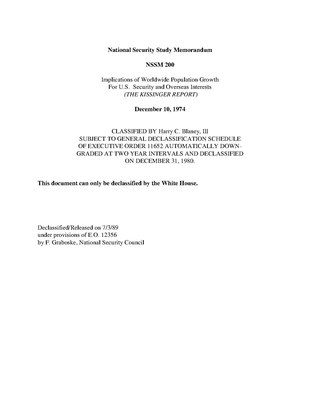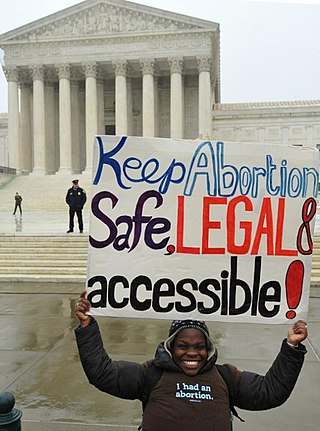Related Research Articles
Sterilization is any of a number of medical methods of permanent birth control that intentionally leaves a person unable to reproduce. Sterilization methods include both surgical and non-surgical options for both males and females. Sterilization procedures are intended to be permanent; reversal is generally difficult.

Human population planning is the practice of managing the growth rate of a human population. The practice, traditionally referred to as population control, had historically been implemented mainly with the goal of increasing population growth, though from the 1950s to the 1980s, concerns about overpopulation and its effects on poverty, the environment and political stability led to efforts to reduce population growth rates in many countries. More recently, however, several countries such as China, Japan, South Korea, Russia, Iran, Italy, Spain, Finland, Hungary and Estonia have begun efforts to boost birth rates once again, generally as a response to looming demographic crises.

Family planning is the consideration of the number of children a person wishes to have, including the choice to have no children, and the age at which they wish to have them. Things that may play a role on family planning decisions include marital situation, career or work considerations, financial situations. If sexually active, family planning may involve the use of contraception and other techniques to control the timing of reproduction.

Birth rate, also known as natality, is the total number of live human births per 1,000 population for a given period divided by the length of the period in years. The number of live births is normally taken from a universal registration system for births; population counts from a census, and estimation through specialized demographic techniques. The birth rate is used to calculate population growth. The estimated average population may be taken as the mid-year population.
Reproductive rights are legal rights and freedoms relating to reproduction and reproductive health that vary amongst countries around the world. The World Health Organization defines reproductive rights as follows:
Reproductive rights rest on the recognition of the basic right of all couples and individuals to decide freely and responsibly the number, spacing and timing of their children and to have the information and means to do so, and the right to attain the highest standard of sexual and reproductive health. They also include the right of all to make decisions concerning reproduction free of discrimination, coercion and violence.

Sub-replacement fertility is a total fertility rate (TFR) that leads to each new generation being less populous than the older, previous one in a given area. The United Nations Population Division defines sub-replacement fertility as any rate below approximately 2.1 children born per woman of childbearing age, but the threshold can be as high as 3.4 in some developing countries because of higher mortality rates. Taken globally, the total fertility rate at replacement was 2.33 children per woman in 2003. This can be "translated" as 2 children per woman to replace the parents, plus a "third of a child" to make up for the higher probability of males born and mortality prior to the end of a person's fertile life. In 2020, the average global fertility rate was around 2.4 children born per woman.

Compulsory sterilization, also known as forced or coerced sterilization, is a government-mandated program to involuntarily sterilize a specific group of people. Sterilization removes a person's capacity to reproduce, and is usually done through surgical procedures. Several countries implemented sterilization programs in the early 20th century. Although such programs have been made illegal in most countries of the world, instances of forced or coerced sterilizations persist.

National Security Study Memorandum 200: Implications of Worldwide Population Growth for U.S. Security and Overseas Interests (NSSM200), also known as the "Kissinger Report", was a national security directive completed on December 10, 1974 by the United States National Security Council under the direction of Henry Kissinger following initial orders from President of the United States Richard Nixon.
Religious adherents vary widely in their views on birth control. This can be true even between different branches of one faith, as in the case of Judaism and Christianity. Some religious believers find that their own opinions of the use of birth control differ from the beliefs espoused by the leaders of their faith, and many grapple with the ethical dilemma of what is conceived as "correct action" according to their faith, versus personal circumstance, reason, and choice. This article will discuss various views on birth control of the major world religions Christianity, Buddhism, Judaism, Islam, Hinduism, and Baha'i.

Reproductive justice is a critical feminist framework that was invented as a response to United States reproductive politics. The three core values of reproductive justice are the right to have a child, the right to not have a child, and the right to parent a child or children in safe and healthy environments. The framework moves women's reproductive rights past a legal and political debate to incorporate the economic, social, and health factors that impact women's reproductive choices and decision-making ability.

Birth control, also known as contraception, anticonception, and fertility control, is the use of methods or devices to prevent unintended pregnancy. Birth control has been used since ancient times, but effective and safe methods of birth control only became available in the 20th century. Planning, making available, and using human birth control is called family planning. Some cultures limit or discourage access to birth control because they consider it to be morally, religiously, or politically undesirable.
The following outline is provided as an overview of and topical guide to obstetrics:

Family planning in India is based on efforts largely sponsored by the Indian government. From 1965 to 2009, contraceptive usage has more than tripled and the fertility rate has more than halved, but the national fertility rate in absolute numbers remains high, causing concern for long-term population growth. India adds up to 1,000,000 people to its population every 20 days. Extensive family planning has become a priority in an effort to curb the projected population of two billion by the end of the twenty-first century.

Birth control in the United States is available in many forms. Some of the forms available at drugstores and some retail stores are male condoms, female condoms, sponges, spermicides, and over-the-counter emergency contraception. Forms available at pharmacies with a doctor's prescription or at doctor's offices are oral contraceptive pills, patches, vaginal rings, diaphragms, shots/injections, cervical caps, implantable rods, and intrauterine devices (IUDs). Sterilization procedures, including tubal ligations and vasectomies, are also performed.
Alix Marian Freedman is an American journalist, and ethics editor at Thomson Reuters.

Access to safe and adequate sexual and reproductive healthcare constitutes part of the Universal Declaration of Human Rights, as upheld by the United Nations.

Globally approximately 45% of those who are married and able to have children use contraception. As of 2007, IUDs were used by about 17% of women of child bearing age in developing countries and 9% in developed countries or more than 180 million women worldwide. Avoiding sex when fertile is used by about 3.6% of women of childbearing age, with usage as high as 20% in areas of South America. As of 2005, 12% of couples are using a male form of contraception with rates of up to 30% in the developed world.
Frederick S. Jaffe (1925–1978) was a vice president of Planned Parenthood Federation of America, and founder of what is now the Guttmacher Institute. He was an advocate for increasing the availability of family planning services in the United States. Through his publications and consultations Jaffe argued for birth control as a matter of health and human rights. He was instrumental in developing public support for federal financing of family planning programs, among them the landmark Title X of the Public Health Service Act, passed by Congress in 1970. For his contributions to public health Jaffe was elected to the Institute of Medicine of the National Academy of Sciences in September 1977.
Stratified reproduction is a widely used social scientific concept, created by Shellee Colen, that describes imbalances in the ability of people of different races, ethnicities, nationalities, classes, and genders to reproduce and nurture their children. Researchers use the concept to describe the "power relations by which some categories of people are empowered to nurture and reproduce, while others are disempowered," as Rayna Rapp and Faye D. Ginsburg defined the term in 1995.
Sterilization of Latinas has been practiced in the United States on women of different Latin American identities, including those from Puerto Rico and Mexico. There is a significant history of such sterilization practices being conducted involuntarily, in a coerced or forced manner, as well as in more subtle forms such as that of constrained choice. Forced sterilization was permissible by multiple states throughout various periods in the 20th century. Issues of state sterilization have persisted as recently as September 2020. Some sources credit the practice to theories of racial eugenics.
References
- 1 2 Curriculum vitae, retrieved 2011-01-22.
- ↑ "Statement of Dr. Stephen D. Mumford", Fertility and Contraception in America: Hearings Before the Select Committee on Population, Ninety-fifth Congress, Second Session, United States. Congress. House. Select Committee on Population, vol. 1, U.S. Government Printing Office, 1978, p. 197
- ↑ Corea, Gena (1980), "The Depa-Provera Weapon", in Holmes, Helen B.; Hoskins, Betty B.; Gross, Michael (eds.), Birth Control and Controlling Birth: Women-Centered Perspectives, Contemporary Issues in Biomedicine, Ethics, and Society, Humana Press, p. 107, ISBN 978-0-89603-022-0
- ↑ Abortions necessary in future, expert says, UPI, July 22, 1984
- ↑ "Contraceptive controversy: An unorthodox, and some say risky, pill being promoted to sterilize women in poorer nations has implications for U.S. immigration, a researcher says.", The Atlanta Journal-Constitution, June 19, 1998
- ↑ George, Nirmala (July 25, 1998), "Govt drags feet on quinacrine threat", Indian Express[ permanent dead link ]
- ↑ Freedman, Alix M. (June 30, 1998), "Quinacrine's vast appeal, considerable dangers", Newsday
- ↑ Article - Why the Church can't change Archived June 22, 2010, at the Wayback Machine